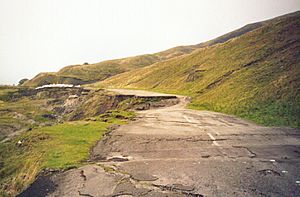Shear stress facts for kids
Shear stress is a type of stress that happens when a force pushes parts of an object in opposite directions, parallel to a surface. Imagine pushing the top of a deck of cards sideways while the bottom stays still – that's a bit like shear stress. It's different from normal stress, which pushes or pulls straight into or out of a surface.
Shear stress is important in many areas, like when fluids (liquids or gases) move over surfaces. It also plays a big role in how soil behaves. For example, a heavy dam built on earth might cause the ground underneath to slide, similar to a small landslide, because of shear stress.
Contents
What is Shear Stress?
When you push or pull on an object, it creates a force inside that object called stress. Think of stress as the internal forces that particles within a material exert on each other. There are different kinds of stress. Shear stress happens when the force acts along the surface of the material, like when you try to slide one part of an object past another.
How is it Different from Normal Stress?
To understand shear stress better, let's compare it to normal stress.
- Normal stress is when a force pushes or pulls straight into or out of a surface. Imagine pushing down on a table or pulling on a rope. The force is perpendicular (at a 90-degree angle) to the surface.
- Shear stress is when the force acts parallel to the surface. It tries to make one part of the material slide over another. Think of cutting paper with scissors. The blades apply shear stress to the paper, making it tear along the line of the cut.
Where Can We See Shear Stress?
Shear stress is all around us and affects many things, from how fluids flow to how buildings stand strong.
Shear Stress in Fluids
When a fluid like water or air moves, it can create shear stress on surfaces it touches. For example, when wind blows over the roof of a house, it creates shear stress on the roof's surface. This is also why boats feel resistance when moving through water – the water creates shear stress on the boat's hull.
Shear Stress and Soil
Soil, like the ground we walk on, can also experience shear stress. This is very important in civil engineering and geology.
- Landslides: When a hillside becomes too steep or too wet, the weight of the soil can create shear stress that is too much for the ground to handle. This causes the soil to slide downhill, resulting in a landslide.
- Dams and Buildings: Engineers must consider shear stress when building large structures like dams or tall buildings. The weight of these structures can push down on the soil, creating shear forces that could cause the ground to shift or collapse if not properly designed.
Everyday Examples of Shear
You might not realize it, but you see or use shear stress every day!
- Scissors: As mentioned, scissors work by applying shear stress. The two blades slide past each other, cutting through paper, fabric, or hair.
- Cutting Food: When you slice a carrot with a knife, the knife applies shear stress to the carrot, causing it to separate.
- Walking: When you walk, your feet push against the ground. This creates shear stress between your shoes and the ground, which helps you move forward without slipping.
Related Topics
See also
 In Spanish: Tensión cortante para niños
In Spanish: Tensión cortante para niños


